On The Record with Siena Water Polo’s Tamara Perea
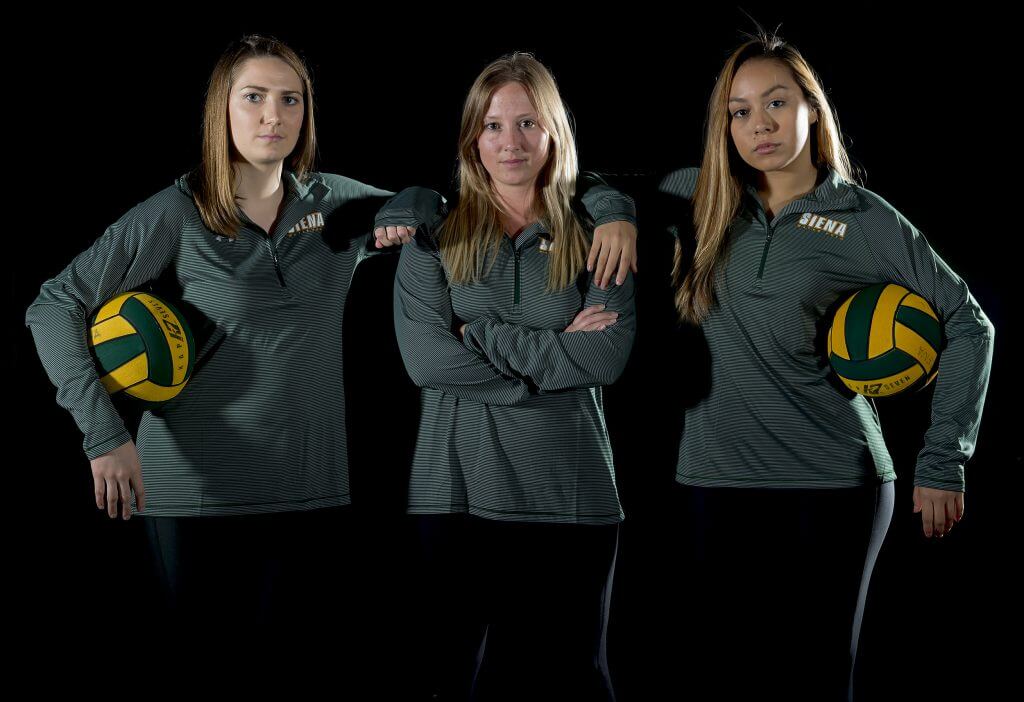
By Michael Randazzo, Swimming World Contributor
Editor’s Note: Swimming World kicks off its coverage of the 2018 NCAA Women’s Varsity water polo. Look for interviews, conference predictions and the best coverage of the sport in America and beyond.
Tamara Perea has taken on a big challenge: changing the culture around women’s water polo at Siena College. In their 14 seasons of play in the Metro Atlantic Athletic Conference, the Saints have never posted a winning season—they went 15-15 in 2007—and have qualified for the MAAC playoffs twice: in 2008 and 2010.

Hired last August to replace Ellen Howe, who in 10 years went 87-212, Perea has both the experience and temperament to engineer a turnaround at Siena, a small Catholic college 13 miles outside of Albany, NY. Growing up on the periphery of the water polo-crazy culture of Southern California, she had the good fortune in high school and college to play for Alex Rodriguez, one of the brightest coaches in the country.
A scholarship to Pomona-Pitzer not only solidified her connection w/ Rodriguez, who coaches both men’s and women’s polo at Pomona, but led to great success for both Perea and the Sagehens. In 2010, she was named the Southern California Intercollegiate Athletic Conference (SCIAC) Athlete of the Year, and in both 2010 and 2011 was selected as the NCAA Division III Player of the Year. Perea was also named Pomona-Pitzer’s Most Valuable Athlete both of those seasons. She graduated as the program’s all-time leading scorer, while also helping the squad to two SCIAC titles, two NCAA tournaments and a Division III national championship.
After a year playing professionally for La Latina in Spain, Perea joined Rodriguez’s staff, first in 2012 as an assistant to the men’s program, and then from 2013-16 as assistant coach to the women’s team. A stint last season at Marist as assistant coach on Chris Vidale’s staff prepared Perea for the particular circumstances of the MAAC, where the majority of schools play in shallow-deep pools.
Over the New Year’s holiday Swimming World spoke with Perea about her new position, her experience playing polo in California and abroad, the challenge of recruiting for Northeastern programs, and her plans to transform Siena water polo.
– How did you get started playing water polo?
I was seven years old and all my cousins were playing for La Serna and Coach [John] Murphy. He brought out a peanut ball one day and asked if we wanted to play with it. I was hooked. He called my sister and me the “A Team.”
When you experience first-hand a coach that just wants people to love the sport at whatever age and play however they want to—that’s a way to bring people in. I’ve now been playing for 20 years.
– Is it fair to say that water polo in California is unlike anywhere else in the world?
You’re probably thinking Orange County, which is the center of [SoCal] water polo. Not so much inland where I was from. We had to fight for recognition out there.
It’s like any other obscure sport in California, and we have so many. It’s not like we were big time anywhere we went. We could get games whenever we needed games—I always felt that was important—as well as having access to so many different pools.
– Was it a natural fit that you would attend at Pomona-Pitzer?
I was a fairly under recruited athlete. I was only the second person in my family to go to college; my sister Suzanne who went before me wasn’t an athlete. As far as the recruiting process I didn’t have a leg up on anybody. Luckily, I did know Alex—he coached me at club as well.
Long story short, I didn’t apply to many schools; I’m not sad that I didn’t. I only applied to San Diego State and [Carin Crawford] only offered me a walk-on [spot]. I’m glad I never looked back.
– What’s it like to play for Alex Rodriguez?
It was completely by chance that I joined his club at 15. One of the first things he ever said about me is he called me “coach.” I was yelling on the sideline beside Terry Kimberling, the age-group coach I was playing for. I was barking out orders the same way.
That’s something that you don’t forget, and when it becomes time to choose who you play for, you pick that person who’s going to bring out the best in you. He always really has.
– Playing at Pomona-Pitzer was very successful for you individually and for your team.
I went to [NCAAs] my freshman year and my junior year. Everything related to water polo—I was taught this—I treated as something I’d never experienced before. To navigate through life using water polo. Everything I’ve ever traveled for or seen the world with has been through water polo.
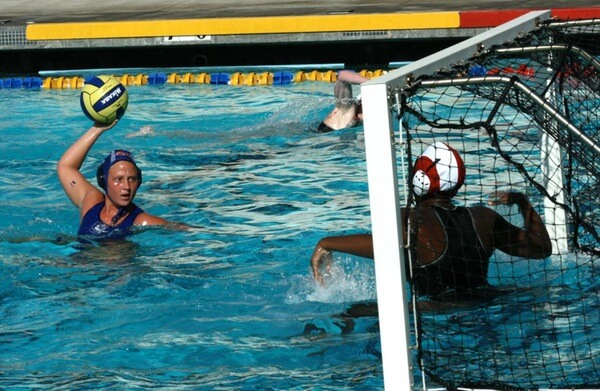
Perea playing for Pomona. Photo Courtesy: Pomona-Pitzer Athletics
NCAAs is not something every athlete gets to experience. Playing for a DIII school, not going to those poor former MPSF teams that would never go because UCLA and USC [qualified ahead of them]. Playing DIII water polo was a conscious choice, and using that as an avenue, winning conference, that was huge. My goal is to get back there some day with my own team.
– How will your experience playing as a Sagehen translate to coaching Siena?
I know what it means to grind. I know what an uphill battle feels like. And I know what the sweetest part of winning that is. It’s not even the “W”; that’s now why we do what we do. Otherwise a lot of people wouldn’t venture down this road.
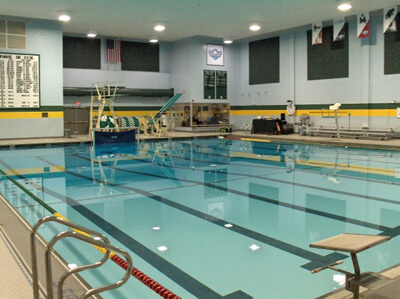
Siena’s shallow-deep pool
If you’re used to the grind you know what it takes to win, you know what it feels like to make that tournament, you know what it means to every other athlete there. Not even because you know you’re not going to win a championship; that’s never the case. There’s always pressure—which might be self-inflicted. That’s something that I want to bring to Siena and the MAAC. I want everyone to know that water polo deserves to be on the East Coast.
Marist and Wagner are doing a very good job at trying to compete at the highest level. Siena hasn’t always been at the forefront but I believe we can reach that potential one day. I obviously want to be a part of that. And I’d like that experience for any athlete that I coach.
– For much of the past decade the MAAC has been dominated by two teams: Wagner and Marist. How can Siena cut in on this duet?
Recruiting and showing up. I want to get into all the best tournaments. I want to show that I can compete. I want all of the girls to demonstrate skills that everybody is using. And I’m not just looking at California athletes. Developing the sport around the country is the most important thing related to recruiting for the MAAC.
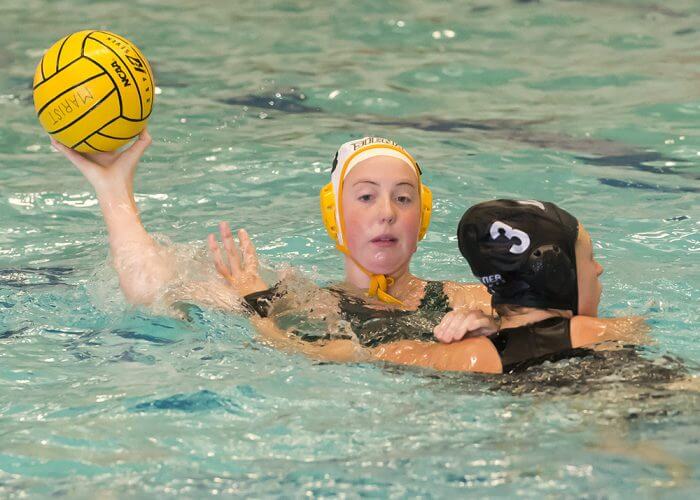
Terez Touhey. Photo Courtesy: Siena Athletics
I see very little value to picking those name players that UCLA, Stanford and USC are recruiting. There’s so much untapped talent from all over the country. St. Louis is starting clubs, Florida is picking up some speed. Chicago is a really great place. Pennsylvania is doing good things and up in the Northwest as well. There’s some great players coming out of Seattle.
That is what’s going to get the sport going in the Northeast; given people more options to play and demonstrating the value of an education here as well as an athletic career at any of these schools. That’s definitely going to happen if we keep competing—and I’m really excited to my name in that race [for a MAAC title] among Marist, Wagner and even Iona.
– You’ve had international playing experience. How do European players benefit American water polo?
I see value in the game that the Europeans play—frankly any country that has its own club—they bring their own experience. Academies run by their own sports federations, they’ve been brought up to be that athlete and then they’re hand-picked out of all the other athletes who are constantly competing against each other. That’s not something that exists here.
We’re getting somewhat close but it’s nothing like what they do. There’s value in their experience, there’s value in their competitive drive because they’ve been taught that there’s a lot more at stake in their performance. That’s why they bring value to every program they’re a part of and why coaches seek them out.
It’s a win-win for everybody. It’s not that an entire squad should be international but I believe that having international players is good thing for the sport at the college level.
– What will change the culture for the Saints?
I start with accountability. Accountability to yourself and to each other. That’s really what it boils down to.
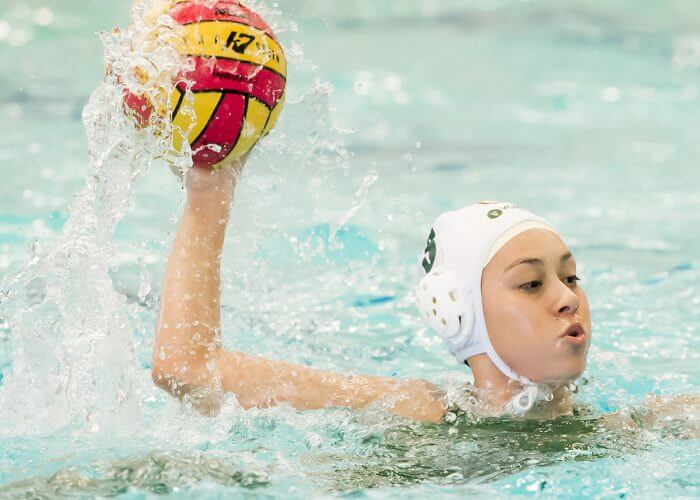
Diana Fernandez. Photo Courtesy: Siena Athletics
We have a solid mix of players from across the country. One of the most exciting things about my squad is that I have an opportunity to develop athletes who haven’t really experienced that side of water polo.
They work hard every day—that’s been a factor in every single practice that I’ve coached—I couldn’t ask for anything more from our athletes. That gives me something to work with.
Am I going to predict that we’re going to win MAACs this year? Not at all. But we’ve set goals where we want to get fourth or fifth this season. Fourth would obviously making the MAAC tournament—which is a personal goal for mine.
– You were hired in late August, after all recruiting for this season was done, so your coaching is going to be a difference maker this season.
I know what it feels like to hustle; I know what it feels like to grind for what you want.
When it comes to leading by example I am forever growing as a human being. I want to demonstrate that to my athletes that we’re always growing [and] we’re not perfect. I also want the girls to know that we’re all incomplete and have something new to learn. The biggest thing I want to convey as a coach is that I don’t know everything.
I talk about my experiences but I don’t know what’s taken hold yet. We’ll see! [Laughs].
– How do you forecast Siena’s chances in the MAAC this season?
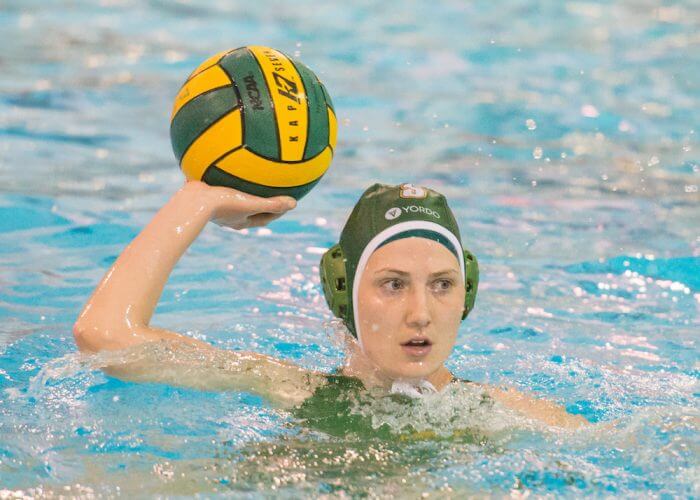
Clare Bryar. Photo Courtesy: Siena Athletcs
That first weekend [ March 10-11] we’re hosting all four teams that we want to measure ourselves against. We’re playing Marist and Wagner in the same weekend and we’re also playing Villanova and St. Francis, which are two games where I’m hoping we will take care of business.
We’re testing ourselves very early on. We can look at that two ways; very negative, as in: “If only we had more time!” or—and this is my plan—use it as a way to test ourselves early. To actually give ourselves a chance to see where we measure up and build from there.
– The Saints should have ample offense—Clare Bryar, Diana Fernandez, Terez Touhey, your top three in scoring last year—are all returning. It looks like defense is your team’s greatest challenge this season.
I’m truly excited about my freshman defender, Sophia Torres. She’s from Texas and, when I mentioned earlier where players come from that people don’t think about, she’s my lefty, she’s long, she’s tenacious and she wants to get better every single day.
We recently played at St. Francis and played against Iona. Sophia took her lumps but I was really excited about her match-up with Hannah Schultz [2017 MAAC Co-Offensive Player of the Year]. That’s saying quite a bit. I’m excited to develop her over the course of the season.
I think Sophia will be very important to our defense and what I want to do with it.
– What about your goalie situation? Will junior Kennedy Joseph handle the majority of netminding duties?
I’m currently training two goalies. Nikki Feldtz is the other. She played in the field last season but was a goalie in high school. This year she asked to train as a goalie. I’m more than likely to use her as a field player as well.
I’ve got a little hybrid going on, and I think Nikki and Kennedy Joseph are going to do a great job.
Keeping the squad dynamic and utilizing that I have 12 athletes. If I carry two goalies only, I’m rocking with four subs and that’s not enough depth for anybody. Having Nikki translates into more rest for my players, different looks as far as teams.
It gives me a chance to actually strategize, which is really important.
– You spent a year as assistant coach with Marist’s Chris Vidale. How will that experience benefit you?
You mean because I’ve seen his play book? [Laughs]. I learned a lot from Chris during the time I was working for him. That was his first college head coaching position. He always brought a lot of energy, a lot of positivity. It reminded me why I like coaching. He and I vibed on so many things related to what was important to us when it came to the sport and playing ball.
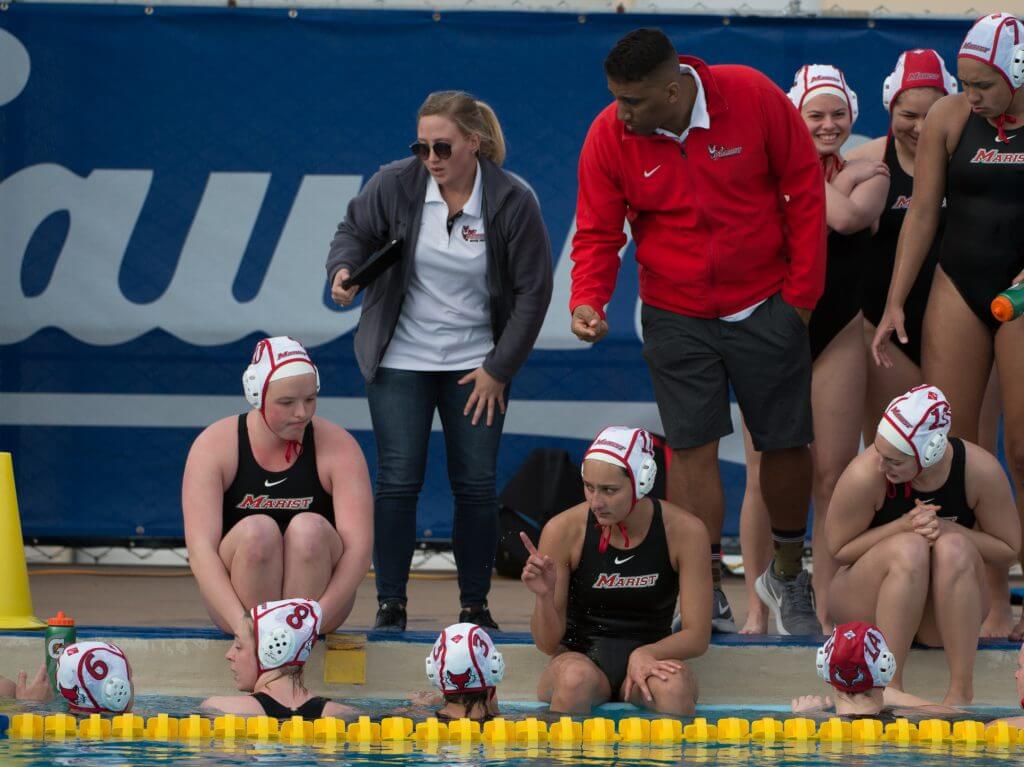
Perea coaching last season at Marist. Photo Courtesy: Eric Isaacs/UCSB
[That experience] was a really solid reminder of what I really want to do, how I wanted to do it and why I loved playing. I want to bring that back to my coaching.
In terms of knowing what Marists’ plays are, that will be one thing. Knowing his athletes will also be helpful with match-ups. Keeping it competitive and making Marist and Wagner play their best six against my best six the whole game long instead of getting into their depth—that’s my ultimate goal against those two squads.




Excellent wonderfully structured piece. Great questions. Delivers tons of detail with fantastic energy. Great stuff ! – jmr
John:
Thank you for your kind words! While I appreciate the ego-gratification (!) I must defer to Coach Perea, who was a GREAT interview. Her honest appraisal of Siena WWP struck me as the right attitude for lifting the Saints’ spirits — and results.
All the best for a happy + healthy 2018,
Your correspondent